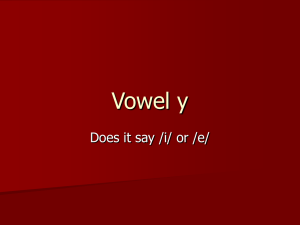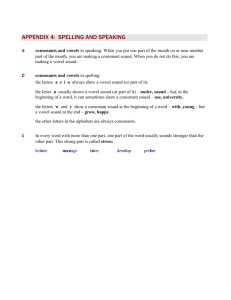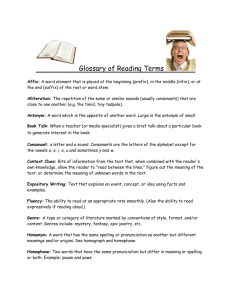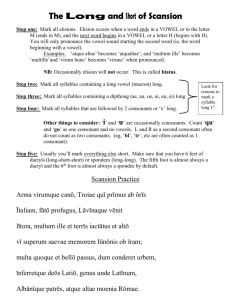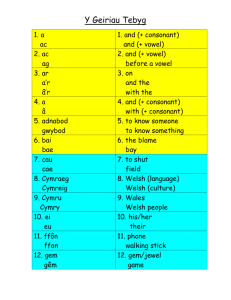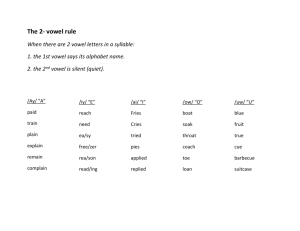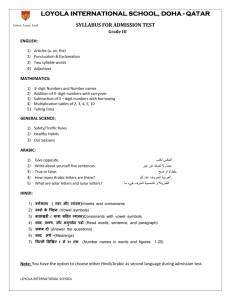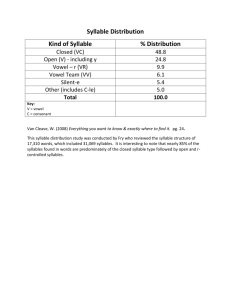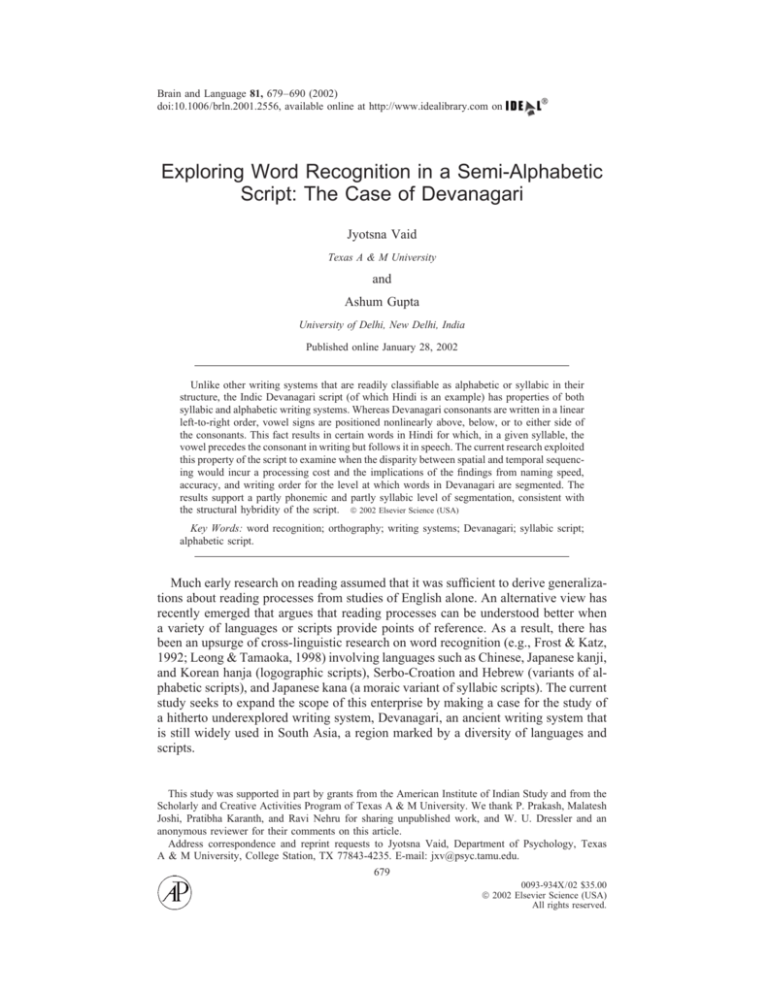
Brain and Language 81, 679–690 (2002)
doi:10.1006/brln.2001.2556, available online at http://www.idealibrary.com on
Exploring Word Recognition in a Semi-Alphabetic
Script: The Case of Devanagari
Jyotsna Vaid
Texas A & M University
and
Ashum Gupta
University of Delhi, New Delhi, India
Published online January 28, 2002
Unlike other writing systems that are readily classifiable as alphabetic or syllabic in their
structure, the Indic Devanagari script (of which Hindi is an example) has properties of both
syllabic and alphabetic writing systems. Whereas Devanagari consonants are written in a linear
left-to-right order, vowel signs are positioned nonlinearly above, below, or to either side of
the consonants. This fact results in certain words in Hindi for which, in a given syllable, the
vowel precedes the consonant in writing but follows it in speech. The current research exploited
this property of the script to examine when the disparity between spatial and temporal sequencing would incur a processing cost and the implications of the findings from naming speed,
accuracy, and writing order for the level at which words in Devanagari are segmented. The
results support a partly phonemic and partly syllabic level of segmentation, consistent with
the structural hybridity of the script. 2002 Elsevier Science (USA)
Key Words: word recognition; orthography; writing systems; Devanagari; syllabic script;
alphabetic script.
Much early research on reading assumed that it was sufficient to derive generalizations about reading processes from studies of English alone. An alternative view has
recently emerged that argues that reading processes can be understood better when
a variety of languages or scripts provide points of reference. As a result, there has
been an upsurge of cross-linguistic research on word recognition (e.g., Frost & Katz,
1992; Leong & Tamaoka, 1998) involving languages such as Chinese, Japanese kanji,
and Korean hanja (logographic scripts), Serbo-Croation and Hebrew (variants of alphabetic scripts), and Japanese kana (a moraic variant of syllabic scripts). The current
study seeks to expand the scope of this enterprise by making a case for the study of
a hitherto underexplored writing system, Devanagari, an ancient writing system that
is still widely used in South Asia, a region marked by a diversity of languages and
scripts.
This study was supported in part by grants from the American Institute of Indian Study and from the
Scholarly and Creative Activities Program of Texas A & M University. We thank P. Prakash, Malatesh
Joshi, Pratibha Karanth, and Ravi Nehru for sharing unpublished work, and W. U. Dressler and an
anonymous reviewer for their comments on this article.
Address correspondence and reprint requests to Jyotsna Vaid, Department of Psychology, Texas
A & M University, College Station, TX 77843-4235. E-mail: jxv@psyc.tamu.edu.
679
0093-934X/02 $35.00
2002 Elsevier Science (USA)
All rights reserved.
680
VAID AND GUPTA
From a theoretical perspective, Devanagari is of interest because of its unique
linguistic design, reflecting the operation of both alphabetic and syllabic principles. Yet little is currently known about how beginning or skilled users of this writing system are influenced by the design of the script. There have been several case
reports examining the influence of syllabic writing systems on reading and writing
disorders (e.g., Karanth, 2002). Recent work with normal and dyslexic readers of
Hindi (Gupta, Vaid, & Garg, 1997; Nehru & Garg, 1997) highlights specific problems
in Hindi spelling related to vowel length and vowel placement confusion. A similar
difficulty has been observed with so-called bundled consonants in this script (e.g.,
Nehru, Prasannanshu, & Garg, 1997), that is, consonants combined with other consonants in ligatures, a common feature of Devanagari.
Some preliminary work on reading acquisition of Brahmi scripts, of which Devanagari is a variety (see below), suggests that phonemic awareness might not play as
important a role for such scripts as it appears to play for most other alphabetic scripts
(see, e.g., work with readers of other Brahmi scripts such as Patel & Soper, 1987,
with Gujarati and Prakash, Rekha, Nigam, & Karanth, 1993, with Kannada). Yet
comparisons of Hindi literates versus illiterates (Prakash et al., 1993) suggest that,
under specific test conditions, phonemic segmentation (specifically phoneme deletion) can reliably occur provided there are graphemic representations of the phonemes. Similarly, while some research on readers of Kannada suggests the presence
of a syllable-based level of analysis in reading acquisition (Prakash et al., 1993;
Prakash, 2001), other research suggests a facilitatory effect of prior explsure to Kannada (relative to Chinese) in the acquisition of spelling in a novel alphabetic orthography (Joshi, Aaron, & Hoein, 2000).
Clearly, much more work is needed to ascertain the nature and range of effects
of orthography on literacy acquisition and on processes underlying word recognition
in beginning and proficient users of structurally hybrid scripts such as Devanagari.
The current research was designed to examine the processing implications of one
particular property of the Devanagari writing system, namely, consonant–vowel positioning. In what follows, we first present some background information about this
script.
History of Devanagari
Nearly all of the 200 or so different written languages used in the Indian subcontinent today derive from a single script, Brahmi, which emerged during the 3rd century
in the Ashokan inscriptions and has a Semitic source possibly dating as far back as
the 5th century BC. Brahmi-derived scripts are subdivided into northern and southern
groups, the Gupta and the Grantha, respectively. The northern group (of which Devanagari is a derivative) extends from northwestern India to Nepal and Tibet in the
north, across the subcontinent to Bengal and what is now Bangladesh, and further east
to Southeast Asia (including Thailand, Indonesia, and Korea). The Grantha group,
in turn, is a precursor of the Dravidian scripts (i.e., Tamil, Telegu, Kannada, and
Malayalam), used predominantly in South India. Devanagari, as the script of Sanskrit
literature, became the most widely used script in India by the 11th century. Today
it coexists with at least nine other major scripts in India, including Roman and PersoArabic. Languages written in Devanagari include Nepali, Marathi, Bengali, Gujarati,
and Hindi (the latter is the fourth and most frequently used language in the world)
as well as Tibetan and Burmese.
The phonological design of Brahmi was influenced by cognitive demands on
memory placed by the need to learn, store, and recite long poetic compositions and
WORD RECOGNITION IN DEVANAGARI
681
Vedic texts. The unit of timing chosen was the matra, which corresponds to what
we now refer to as the mora. A short vowel was accorded the value of one
matra, a long vowel two matras, and a consonant usually a half-matra. The orthographic unit of Brahmi scripts was known as the akshara, which may be viewed
as a historical antecedent of the mora. The akshara can encode V, C, CV, CCV,
CCCV, CVV, CCVV, and CCCVV as units. The nucleus, either by itself or with
the onset, can form an akshara, or the coda by itself can form one or can be moved
on to the next akshara, where it is integrated into the onset of the following syllable (Patel, 1995). While the particular visual shape of aksharas differs in North
and South Indian languages, the underlying phonological principles and topographic encoding are the same. The akshara representation of words would appear
to allow for easily recognizable subsyllabic segmentation. Children who begin to
read in Hindi, Gujarati, or Kannada are exposed to aksaras as whole units. While
they do not do particularly well on tests of phonemic segmentation, they still
learn to read successfully, a finding that has been problematic for prevailing models of reading acquisition, which have largely focused on Western alphabetic
systems.
Characteristics of Devanagari
The Devanagari alphabet originated as the script used to write down Sanskrit.
It consists of 48 letters and additional diacritical signs that together represent every
sound of the Sanskrit language (Bright, 1996). The arrangement of the alphabet is
strictly phonetic, with letters classified by place of articulation: vowels and diphthongs first, then consonants with an inherent implicit schwa vowel. (In Devanagari,
consonant letters are used to represent both the consonant and schwa, unless marked
otherwise.) The letters are arranged in seven groups, as below (Fig. 1).
682
VAID AND GUPTA
Although early Brahmi was written from right to left, Devanagari is written and
read from left to right. Words in Devanagari are written with a horizontal bar linking
the letters. Word boundaries (indicated by a break in the upper line) occur at junctures
coinciding with breath pauses in connected discourse. The letters are printed (there
being no cursive style), and there are no upper- versus lowercase distinctions.
Devanagari Script: Syllabic or Alphabetic?
Like other Brahmi-derived scripts, Devanagari has syllabic as well as alphabetic
properties. These properties are described below.
1. Consonants in Devanagari are pronounced with an inherent short schwa vowel,
which has no independent graphemic form. Consonant clusters are written one
above the other, either by forming ligatures involving a half-consonant attached
to a full one or by having a special sign added to indicate the absence of the
schwa.
2. Vowels are graphemically marked for length and appear in full form (in wordinitial position) or as diacritical signs (in medial or word-final position). Unlike
Semitic languages such as Hebrew, where vowel diacritics may be omitted in
adult writing (Navon & Shimron, 1984), in Devanagari they are obligatory. In
noninitial positions, vowel forms are placed nonlinearly above, below, or to the
left or right of the consonants they modify.
In light of these properties of Devanagari, one may raise the question as to whether
the script is processed more like a syllabic or an alphabetic script. The fact that
each consonant in Devanagari has an inherent associated vowel distinguishes it from
alphabetic scripts, such as Hebrew, whose consonants stand alone as phonemes. However, in contrast to a purely syllabic script that would employ distinctly different
symbols for syllables such as ‘‘ka’’ versus ‘‘ku,’’ in Devanagari the symbols for
these syllables share a common graphic sign corresponding to the phoneme ‘‘k’’ and
diacritical signs corresponding to the different vowel sounds. Because consonants in
this script are written in a strict left-to-right linear order, whereas vowels are essentially subsidiary and are positioned nonlinearly around the consonants, Indic scripts
are sometimes described as ‘‘augmented consonantal’’ systems. Interestingly, some
Southeast Asian scripts, such as Korean Hangul, have borrowed this feature into their
writing systems. Indeed, Indic scripts and Hangul may be syllabic primarily in the
sense that graphemes representing consonants are spatially grouped together with
vowel signs to form a syllabic bundle (Gaur, 1995).
The current research examines some repercussions for processing of this unique
writing system. Of particular interest was the case of the short /i/ vowel in Hindi.
Unlike other vowels, which are placed below, above, or to the right of the consonant
WORD RECOGNITION IN DEVANAGARI
683
they follow in the spoken word, the short /i/ vowel is placed to the left of the consonant it follows in speech.
Inconsistencies in Vowel Placement: The Case of the Short /i/ Vowel
The case of the short /i/ vowel thus produces an unusual mismatch between the
spoken and written sequences in that the spoken sequence Ci (i.e., consonant followed by the short /i/ vowel) is written as iC. Thus, for example, the word
/sitar/ is written with the vowel diacritic placed before the /s/, resulting in what could
be read as /istar/ if not for the fact that the initial /i/ would be written with the full
vowel symbol rather than the diacritic form. (In Devanagari, words in which the
vowel occurs at the onset use the full form version of the vowel, with the diacritic
form being reserved for vowels in word-medial or word-final positions.) This mismatch between the spoken and visual order does not occur for the long /i:/ vowel,
which always follows the consonant, nor does it characterize words beginning with
the short /i/, such as /idhar/. In the latter case, the vowel (written in its full form)
would be written before the consonant and would precede it in speech as well.
The existence of this interesting discrepancy between spatial positioning and temporal sequencing for words containing the noninitial short /i/ vowel raises an empirical question: Is there a processing cost of this misalignment? The answer could have
implications for the unit used by Hindi readers to segment words. If native readers
in fact segment words in Hindi at the level of individual phonemes (and, more specifically, consonants), then they should be slower to name or recognize words whose
spatial order is discrepant with the spoken order. On the other hand, if Hindi readers
segment words into syllable units, then it should not matter as much where the vowel
is positioned relative to the consonant within the syllable. Only if the vowel positioning crosses syllable boundaries would one expect a processing cost. This happens
for words in which the medial /i/ occurs in the second syllable of a word, in which
case the vowel is actually written to the left of the consonant in the first syllable
(e.g., /masjid/ is written as ⬍misj(a)d⬎). (The use of the internal parentheses in the
preceding example is intended to reflect the implicit schwa that accompanies the
pronunciation of nonfinal consonant letters. In this case, the schwa that would normally follow /m/ is displaced by the insertion of the vowel diacritic /i/.) We suggest
that examining the processing of words with consistent versus discrepant visual and
auditory sequencing may provide insights into whether words in Devanagari are more
phoneme delimited or syllable delimited.
Phoneme-delimited view. If users of Hindi segment words predominantly at phonemic boundaries, then inconsistencies in the spoken and read order of individual
letters might incur a processing cost. Specifically, words for which the spoken and
read order is discrepant (i.e., words containing medial short /i/ words, whether they
occur within a syllable or cross a syllable boundary) might take longer to read aloud
and/or be more susceptible to misreading than are words for which the spoken and
read order is the same (i.e., words containing initial short /i/ words and those containing long /i/:).
Syllable-delimited view. If users of Hindi segment words predominantly at a syllable level, then one might not expect a processing cost of misalignment in spatial
and temporal sequencing, provided the mismatch is within a single syllable. That is,
there should be no difference in the naming latency or accuracy for words that contain
syllables that respect a linear sequence (e.g., those containing a long /i:/) and those
that do not (e.g., those containing a medial short /i/). However, when the positioning
of the medial /i/ crosses syllable units, a processing cost might be expected. In summary, the phoneme-delimited view would predict a processing cost for misaligned
684
VAID AND GUPTA
consonant–vowel sequences, whether these are within a syllable or across syllable
boundaries. By contrast, the syllable-delimited view would predict no processing
costs for misaligned words within a syllable but would predict a cost when the misalignment crosses syllable boundaries.
In what follows, we present three preliminary studies to examine this issue. Experiment 1 examined naming latencies in a sample of 40 adult native readers of Hindi.
Experiment 2 examined naming errors in 10 child readers of Hindi. Experiment 3 examined Hindi writing errors and writing sequence in 10 child and 20 adult readers. In
all cases, the same sample of stimuli was used; that is, stimuli were chosen to vary
systematically in vowel placement. All of the studies were conducted in New Delhi.
EXPERIMENT 1: HINDI NAMING LATENCIES
Naming latencies of adult native readers of Hindi to spatially and temporally
aligned or misaligned bisyllabic Hindi words were examined. Stimuli consisted of
two sets of control words (Types 1 and 2) and two sets of experimental words (Types
3 and 4) as follows. Type 1 (T1) words began with the short /i/ vowel (e.g., /ina:m/
). Type 2 (T2) words had the vowel diacritic for long /i:/ occurring at the very ends
of the words (e.g., /kursi:/). Type 3 (T3) words had the short /i/ vowel positioned
to the immediate left of the consonant whose sound it followed in the first syllable
(e.g., /tilak/). Type 4 (T4) words had the short /i/ vowel positioned two consonants
to the left of the one it followed in speech; specifically, Type 4 words had the vowel
diacritic occurring in writing in the syllable preceding the one it actually occurred
in at the spoken level (e.g., /masjid/).
We hypothesized that if naming latencies are affected by discrepancies in spoken
and read orders (being slower for Type 3 or 4 words relative to Type 1 or 2 words),
then the results would favor a phoneme-based processing account. If naming latencies
are equivalent across Type 3 experimental words and the two control conditions but
slower only for Type 4 words, then a syllable-delimited account would be favored.
Method
Participants. A total of 40 native users of Hindi (18 men and 22 women) recruited from the University of Delhi were tested. They ranged in age from 18 to 24 years.
Stimuli and procedure. All subjects were tested individually. Stimuli consisted of 24 common, bisyllabic Hindi words (most of them nouns) classified into four lists (see Appendix). The two control categories (Types 1 and 2) consisted of words in which vowel placement was consistent with the pronunciation order. Type 1 consisted of 6 words in which the short vowel /i/ occurred as the first syllable, as in
/inam/, and therefore the vowel was written in full form. Type 2 consisted of 6 words in which the long
vowel /i:/ occurred at the end, immediately following the final consonant, as in kursi:/. Types 3 and 4
constituted the two experimental conditions and contained words with the short /i/ vowel diacritic. For
words in Type 3, the vowel occurred in the first syllable, as in /tilak/. For words in Type 4, the /i/ vowel
was pronounced in the second syllable, as in /pundit/, although it was actually written as part of the
first syllable; that is, it was positioned immediately before the final consonant of the first syllable and
therefore was two consonants to the left of the consonant after which it actually occurred in speech.
Thus, for example, in the word /pundit/, the /i/ is written before the /n/.
Each stimulus was presented on a slide and shown twice in a fixed random order for an exposure
duration of 250 ms. A voice reaction time apparatus enabled recording of naming latencies in hundredths
of a second.
Results and Discussion
Mean correct naming latencies per stimulus type were entered into an analysis of
variance (ANOVA) as a function of Stimulus Type. Mean naming latencies per Stim-
685
WORD RECOGNITION IN DEVANAGARI
TABLE 1
Experiment 1: Mean Naming Latencies of Hindi Words by Stimulus Type
(N ⫽ 40 adults)
Aligned
Mean seconds
SD
Misaligned
Type 1
/ina:m/
Type 2
/kursi:/
Type 3
/tilak/
Type 4
/masjid/
.243
.04
.249
.03
.270
.04
.287
.04
Note. T1 ⫽ T2; T1, T2 ⬍ T3, T4; T2, T3 ⬍ T4.
ulus Type (in seconds) are summarized in Table 1. There was a significant effect of
Stimulus Type, F(3, 117) ⫽ 33.22, p ⬍ .00001, such that the aligned words constituting the two control conditions (Types 1 and 2) were named significantly faster than
the misaligned words (Types 3 and 4). Moreover, while Type 1 words were named
as quickly as Type 2 words, all other pairwise comparisons were significant.
To determine whether this pattern of results parallels the estimated frequency of
occurrence of these different word types, we obtained perceived frequency estimates
on the spoken and written subjective frequencies of the 24 stimuli from a separate
sample of 20 native Hindi college students in New Delhi. Each stimulus word was
rated for spoken and written frequency on a scale of 1 to 5 where 1 was very uncommon and 5 was very common. The results of the overall analysis revealed no differential frequency by Stimulus Type, although in general the spoken frequency ratings
were higher than the written ones across all types. A separate analysis of the written
frequency ratings did reveal a Stimulus Type effect, F(3, 20) ⫽ 5.25, p ⬍ .008. The
mean written frequency values (and standard deviations) for the four stimulus types
were as follows: T1 ⫽ 3.90 (0.63), T2 ⫽ 3.52 (0.83), T3 ⫽ 2.58 (0.53), T4 ⫽ 3.06
(0.37). Post hoc comparisons indicated that the two control types were rated as the
most frequent and did not differ from each other. Moreover, T1 was rated as significantly more frequent than T3 and T4, and T2 was rated as significantly more frequent
than T3. Interestingly, the written frequency ratings for T3 and T4 did not differ,
nor was there a difference between T2 and T4. Thus, the slower naming latencies to
Type 4 words relative to the other three types cannot be simply attributed to frequency
differences given that Type 4 words were not rated as being less common than two
of the three other types. There is, of course, a structural difference between the Type
3 and Type 4 stimuli: In the Type 3 words (e.g., /tilak/), there is only one consonant
phoneme and grapheme between the two vowels, whereas in the Type 4 words (e.g., /
masjid/), there are two consonant–phonemes and a consonant–grapheme combination (ligature) between the two vowels. This difference could well add to the complexity of Type 4 words and account for the naming latency pattern observed.
EXPERIMENT 2: HINDI NAMING ERRORS
Experiment 2 examined, in a sample of child readers, whether spatial/temporal
misalignment of noninitial short ı words would disrupt naming accuracy of these
words. Specifically, we wondered whether subjects, in reading aloud, would be likely
to mispronounce the misaligned words to reflect the linear order in which the consonants and vowels are written rather than the actual spoken order. We expected that
potential mispronouncements would be lower for Type 3 than for Type 4 misaligned
words because Type 3 misreadings (e.g., reading /tilak/ as /itlak/) would presumably
686
VAID AND GUPTA
be inhibited by subjects’ knowledge that in the word-initial position the /i/ is written
in full form, not in diacritic form. On the other hand, potential mispronouncements
of Type 4 words (e.g., reading /masjid/ as /masijad/) might be more likely because
the mispronounced rendition would still be orthographically legal.
Method
Participants. A total of 10 native readers of Hindi, ranging in age from 7.5 to 10.0 years, were
tested. Half were in Grades 2 to 4, and the remainder were in Grades 5 and 6. All were recruited from
schools where Hindi was the medium of instruction.
Stimuli and procedure. Stimuli consisted of the same list of 24 Hindi words that had been used in
the previous study. As in Experiment 1, stimuli were visually presented for 250 ms, but each word was
shown only once. All mispronunciations were noted by a research assistant who was unaware of the
purpose of the study.
Results and Discussion
Errors in naming included vowel length errors (e.g., substituting the long /i:/ for
the short /i/), consonant and vowel substitutions, and vowel positioning errors. The
number of incorrectly written words was entered into a 2 (Age Group) ⫻ 4 (Stimulus
Type) ANOVA. The analysis yielded a marginal effect of Age Group, F(1, 8) ⫽
3.09, p ⬍ .11, with younger children tending to make more errors (21.7% vs. 6.7%),
and a significant effect of Stimulus Type, F(3, 24) ⫽ 12.14, p ⬍ .0001. Post hoc
comparisons indicated that frequency of errors in naming T1 words (6.7%) was no
different from that in naming T2 words (6.7%) or T3 words (10.0%). T4 words
showed a significantly higher error rate (33.3%) compared to all of the other types
(see Table 2).
Thus, Type 4 words, which were the ones in which the misalignment was the most
severe, produced significantly more errors in naming than did the control words and
Type 3 misaligned words. In general, the naming errors reflected a propensity to be
influenced by the spatial rather than the temporal order and placing the /i/ after the
first consonant rather than before the second one (e.g., saying /masijad/ for /masjid/
or saying /anitam/ for /antim/). Interestingly, except for one subject (the youngest),
none of the subjects misread Type 3 words (i.e., /tilak/-type words were never
pronounced /iltak/), supporting our expectation that such a rendition would not be
permitted by the orthographic convention according to which vowels in word-initial
position are never written in diacritic form.
The finding that Type 4 words posed the most difficulties in naming accuracy for
both groups of child readers (as reflected in the higher error rate for naming these
words and also in the nature of the errors), together with the finding from the previous
TABLE 2
Experiment 2: Mean Errors in Naming Hindi Words by Stimulus Type
(N ⫽ 10 children)
Aligned
Mean errors
Percentage error
Misaligned
Type 1
/ina:m/
Type 2
/kursi:/
Type 3
/tilak/
Type 4
/masjid/
0.4
6.7
0.4
6.7
0.6
10.0
2.0
33.3
Note. T1 ⫽ T2 ⫽ T3; T1, T2, T3 ⬍ T4.
687
WORD RECOGNITION IN DEVANAGARI
experiment that such words were named more slowly (by adults), points to a particular processing cost associated with these words.
EXPERIMENT 3: ERRORS IN WRITING TO DICTATION
AND ORDER OF WRITING
In this experiment, we examined writing errors made to the stimuli used in the
previous experiments. The order of writing the letters of the misaligned stimuli was
also analyzed to see whether it is guided more by spoken than by the spatial sequence.
A child and adult sample were tested.
Method
Participants. Subjects were 10 children (all had been previously tested in Experiment 2) and a new
sample of 20 adults. The adult sample consisted of native Hindi-speaking college students, with a mean
age of 21.5 years, recruited from Delhi University.
Materials and procedure. Subjects were tested individually in a laboratory room. The list of 24
Hindi words used in the previous two studies was orally administered in a fixed random order. Subjects
were to write down each word on a sheet provided to them. Order of writing and errors in writing were
noted.
Results and Discussion
Writing errors. Writing errors of any sort were noted and classified. Errors included incorrect choice of vowels (e.g., substituting the long /i/ for the short /i/ or
vice versa, substituting a different vowel altogether), ligature errors (e.g., omitting or
adding a half-consonant), consonant substitution errors, and letter positioning errors
(typically involving the vowel). Taken as a whole, errors were most frequent among
those in the youngest group, who had an error rate of 40.8%, relative to the sample
from Grades 5 and 6 (20.0%), with adults having the fewest errors (9.8%).
The overall number of incorrectly written words was entered into a 2 (Age Group)
⫻ 4 (Stimulus Type) ANOVA. The analysis yielded a main effect of Age Group,
F(2, 27) ⫽ 15.54, p ⬍.001, and Stimulus Type, F(3, 81) ⫽ 6.99, p ⬍ .0001, as well
as a Group of Type interaction, F(6, 81) ⫽ 5.33, p ⬍ .0001. The interaction, summarized in Table 3, indicates that the youngest group made the most errors, particularly
for Type 2 and Type 4 words. The majority of these errors involved inappropriate use
of consonant amalgamations as well as vowel confusions, including the placement of
the short /i/. Post hoc comparisons indicated that Type 4 words elicited the greatest
writing errors, particularly for the youngest group (63.3%) as compared to the older
child group (36.7%). Adults showed hardly any writing errors across the stimulus
types (see Table 3).
TABLE 3
Experiment 3: Mean Errors in Writing Hindi Words to Dictation by
Stimulus Type (N ⫽ 20 adults and 10 children)
Aligned
Grades 2–4
Grade 5 and 6
Adults
Misaligned
Type 1
/ina:m/
Type 2
/kursi:/
Type 3
/tilak/
Type 4
/masjid/
1.6 (0.89)
0.6 (0.55)
0.8 (1.06)
3.4 (1.82)
0.8 (0.84)
0.5 (1.0)
1.0 (0.71)
1.2 (1.79)
0.6 (0.51)
3.8 (0.84)
2.2 (2.68)
0.5 (0.89)
Note. Standard deviations are in parentheses. Grades 2–4: T1, T3 ⬍ T2, T4. Grades
5 and 6: T1, T2 ⬍ T4. Adults: T1 ⫽ T2 ⫽ T3 ⫽ T4.
688
VAID AND GUPTA
Writing order preference. For each of the Type 3 and Type 4 words that were
written correctly, it was determined whether the subject’s writing sequence did or
did not follow the spoken (temporal) order. For example, for the word /mina:r/, which
is spelled ⬍imna:r⬎, a spoken order would entail writing letters in the same left-toright sequence as the speech sounds that they represent, that is, M before I before
N, and so on. A spatial order, in turn, would entail writing the /i/ first, followed by
/m/, and so on. In the case of words in Type 4, such as /masjid/ (spelled ⬍misj(a)d⬎),
a temporal sequence was considered to parallel the spoken order if the symbol for
I was written after the J or even after the S. If it were written immediately after the
M, then that was regarded as a left-to-right (spatial) order. Other variations were also
possible in which part of the /i/ diacritic was written and the remaining portion was
completed at the end of writing the rest of the word.
For each subject, the proportions of Type 3 and Type 4 words that respected the
spoken order were entered into a 2 (Age Group) by 2 (Stimulus Type) ANOVA. The
analysis showed no effect of either variable. In general, children and adults appeared
to be predominantly guided by the pronunciation sequence of the words in their sequence of writing the short /i/ vowel, as 68.8% of the Type 3 words and 61.8% of
the Type 4 words were written with the consonant first and then the short /i/ vowel
placed to the left of the consonant. This pattern characterized the writing order for
all Type 3 words for 80.0% of the children and half of the adults. Type 4 words
showed more variability in writing patterns across subjects, but the prevailing sequence was still consonant first, followed by the short /i/ vowel.
In summary, the writing order data clearly demonstrate that subjects follow the
spoken order in guiding their sequence of writing, rather than the sometimes inconsistent left-to-right order prescribed in the standard orthography. As such, these data
underscore the ‘‘augmented consonantal’’ aspect of Hindi/Devanagari, for subjects
clearly focus on the consonants first and then add the appropriate diacritical marks.
GENERAL DISCUSSION
The results of our research indicate that inconsistencies in the spoken spatial sequencing of Hindi words do incur a processing cost. While children and adults typically wrote the letters of the misaligned words in the order in which they are pronounced rather than in the order in which they are positioned spatially, when it came
to reading the words aloud, there was an effect of consistency: Words in which the
spoken and spatial order was discrepant were either read slower (by adults) or, for
Type 4 words in particular, misread (by children), as compared to words in which
spoken and spatial order was consistent. If the processing of words in Hindi is predominantly syllable based, then the specific ordering of the consonants and vowels
constituting a syllable should not be expected to matter. The results suggest instead
that the processing of Devanagari (at least for adult readers and for the types of
materials examined here) may be closer to that characterizing alphabetic scripts than
to that characterizing syllabic scripts (for additional support for the occurrence of
phoneme-level segmentation in Hindi readers under certain orthographic conditions,
see also Prakash et al., 1993).
The sensitivity to vowel placement observed in our sample of normal readers parallels findings from dyslexic readers of Hindi indicating that errors in vowel representation constitute the vast majority of errors in Hindi spelling and reading (Gupta et al.,
1997; Nehru & Garg, 1997; Nehru et al., 1997). Indeed, according to Nehru (2001),
in Hindi dyslexics, error rates on Hindi noninitial vowels and bundled consonants
are about 10 times those on initial vowels and ordinary consonants. Nehru argued
689
WORD RECOGNITION IN DEVANAGARI
that the complexity of spatial configuration of Hindi noninitial vowels and bundled
consonants taxes right hemisphere strategies, already compromised in dyslexic children, and that this results in the laying down of a distorted graphemic neural representation.
Further research with a broader array of stimuli in normal and dyslexic readers is
clearly needed to replicate and extend the current findings and to shed further light
on how the writing system of Devanagari affects word recognition. For example, in
the current research, the Type 4 words (i.e., words in which the short /i/ vowel crossed
syllable boundaries) invariably involved consonant clusters, whereas the Type 3
words (i.e., words in which the vowel was within a syllable) did not involve consonant
clusters. It would be interesting in future work to contrast the heterosyllabic consonant clusters used in the current study (i.e., /masjid/ and /pundit/) with other kinds of
consonant clusters possible and common in Hindi that occur within a given syllable.
Another domain for further research on this topic would involve examining a
broader range of tasks measuring lexical access, specifically, tasks that do not place
as overt demands on phonological assembly as does the naming task. Possible candidates would be lexical decision and priming tasks. Data obtained from such tasks
should further illuminate how orthographic properties of Hindi affect lexical processing and representation.
The current results are clearly preliminary, but they are sufficient, we feel, in arguing that more research with South Asian languages is warranted. Additional research probing script-specific properties will be crucial in furthering our understanding of reading and writing processes in normal and impaired users of different
orthographies, and of semi-syllabic orthographies in particular (see Vaid & Prakash,
in press).
APPENDIX
List of Stimuli
Type 1
Type 2
Type 3
Type 4
/ina:m/
/idhar/
/ila:j/
/itna:/
/iccha:/
/itva:r/
/kursi:/
/jaldi:/
/patni:/
/tasvi:r/
/kulfi:/
/chutni:/
/tilak/
/gila:f/
/bistar/
/mina:r/
/sirka:/
/hisa:b/
/masjid/
/antim/
/pashchim/
/pundit/
/mandir/
/shakti/
REFERENCES
Bright, W. (1996). The Devanagari script. In P. Daniels & W. Bright (Eds.), The world’s writing systems
(pp. 384–390). New York: Oxford Univ. Press.
Frost, R., & Katz, L. (Eds.). (1992). Orthography, phonology, morphology, and meaning. Amsterdam:
North Holland.
Gaur, A. (1995). Scripts and writing systems: A historical perspective. In I. Taylor & D. R. Olson (Eds.),
Scripts and literacy: Reading and learning to read alphabets, syllabaries, and characters (pp. 19–
30). Dordrecht, Netherlands: Kluwer Academic.
Gupta, A., Vaid, J., & Garg, A. (1997). Word–nonword reading in Hindi language by developmentally
dyslexic children. Poster presented at the meeting of the Psychonomics Society, Philadelphia.
Henderson, L. (1984). Writing systems and reading processes. In L. Henderson (Ed.), Orthographies
and readings: Perspectives from cognitive psychology, neuropsychology, and linguistics (pp. 11–
24). Hillsdale, NJ: Erlbaum.
Joshi, R. M., Aaron, P. G., & Hoien, T. (2000). Is the orthographic nature of the script a contributor
690
VAID AND GUPTA
to spelling performance of children? Paper presented at the annual meeting of the Society for the
Scientific Study of Reading, Stockholm.
Karanth, P. (2002). The search for deep dyslexia in syllabic writing systems. Journal of Neurolinguistics,
15, 143–155.
Leong, C. K., & Tamaoka, K. (1998). Cognitive processing of Chinese characters, words, sentences,
and Japanese kanji and kana: An introduction. Reading and Writing, 10, 155–164.
Navon, D., & Shimron, J. (1984). Reading Hebrew: How necessary is the graphemic representation of
vowels? In L. Henderson (Ed.), Orthographies and readings: Perspectives from cognitive psychology, neuropsychology, and linguistics (pp. 91–102). Hillsdale, NJ: Erlbaum.
Nehru, R. (2001). Distorted grapheme representation: A new hypothesis to explain dyslexic reading
errors. Poster presented at the Fifth British Dyslexia Association International Conference, York,
UK.
Nehru, R., & Garg, A. (1977). A cross-linguistic study of biliterate developmental dyslexia. Paper presented at the annual conference of the Indian Academy of Neurology. Madras, India.
Nehru, R., Prasananshu, P., & Garg, A. (1997). Stressed consonant errors on reading aloud in unselected
poor readers. Paper presented at the annual conference of the Psycholinguistics Association of
India, Tirupathi, India.
Paradis, M., Hagiwara, H., & Hildebrandt, N. (1985). Neurolinguistic aspects of the Japanese writing
system. Orlando, FL: Academic Press.
Patel, P. (1995). Brahmi scripts, orthographic units, and reading acquisition. In I. Taylor & D. Olson
(Eds.), Scripts and literacy: Reading and learning to read alphabets, syllabaries, and characters
(pp. 265–276). Dordrecht, Netherlands: Kluwer.
Patel, P. G., & Soper, H. V. (1987). Acquisition of reading and spelling in a syllabo-alphabetic writing
system. Language and Speech, 30, 69–81.
Prakash, P. (2001). Syllabic and phonemic awareness in children acquiring literacy in a semi-syllabic
script. Unpublished manuscript, University of Mysore, Mysore, India.
Prakash, P., Rekha, D., Nigam, R., & Karanth, P. (1993). Phonological awareness, orthography, and
literacy. In R. Scholes (Ed.), Literacy and language analysis (pp. 55–70). Hillsdale, NJ: Erlbaum.
Vaid, J., & Prakash, P. (Eds.). (in press). Reading and writing in syllabic and semi-syllabic scripts.
Special issue of Reading and Writing.

